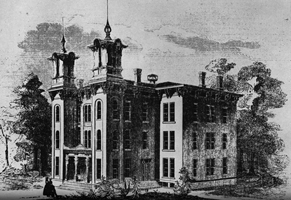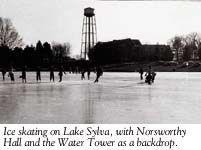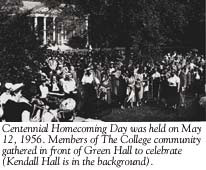Early Years

Our original campus on North Clinton Avenue in Trenton. |
Cost of Tuition, Fees, Room and Board
| 1855* |
$0.00 |
| 1901 |
$160.00 |
| 1940 |
$430.00 |
| 1950 |
$629.00 |
| 1960 |
$983.55 |
| 1970 |
$1,566.50 |
| 1980 |
$2,705.60 |
| 1990 |
$6,646.00 |
| 1999 |
$12,015.00 |
|
Academic Buildings
When approval was given for a Normal School, the
trustees placed ads in papers across the state looking for
land upon which to build the school. Offers came in from
New Brunswick , Beverly, Orange , and many other towns. A
2000 square-foot lot on Clinton Avenue in Trenton was chosen
as the best location to erect the College's first building,
which was a three-story rectangular structure. When classes
started in October 1855 though, the building was not complete,
and the first students attended class in a public hall.
During the second week of the fall 1855 term, classes were
moved to a dwelling house on Hanover and Stockton Streets.
Finally
in the spring of 1856, classes were moved into the newly
constructed building on Clinton Avenue . About this same
time, a Model School was opened on the first floor of
the Normal School. Due to its increasing enrollment, the
Model School soon needed its own facility, and a new building
was constructed on the lot next to the Normal School.
As the curriculum changed and enrollment increased
over the years, the need arose for larger facilities.
By 1890, classrooms were needed for newer subjects such
as manual teaching, drawing, and physical culture. In October
of that year, a new building was built which adjoined
the Model and Normal School buildings. This new building
featured chemistry labs, physics rooms, a manual training
room, a gymnasium, and an auditorium large enough to accommodate
all of the schools' students. It was soon discovered
though that the gymnasium, which was housed on the second
floor of the new building, was inadequate. Subsequently
a new gymnasium, which featured a bowling alley in the
basement, was built around the turn of the last century.
It was enlarged in 1914.
Residential Buildings
The
first students of the Normal School were forced to find
their own room and board. To help them, the College placed
ads in the Trenton newspapers seeking families willing
to provide "plain and simple diet.[and] airy rooms properly
warmed and ventilated, at reasonably moderate rates." Students
paid five to six dollars per week to the families.
Finally,
Principal John S. Hart decided that the expense and difficulty
of finding suitable housing was preventing people from
enrolling. Hart, along with a group of Trenton citizens,
purchased the building across the street from the Normal
and Model Schools and turned it into a women's dormitory,
offering room and board at $3.50 a week. Within a month
all 30 rooms were filled. The group quickly built a new
building big enough to house 100 women. This new building
was three stories tall; each of its rooms housed two
women, was carpeted and furnished with a double bed and
mattress, and included separate clothes closets for each
woman.
When enrollment increased after the Civil War,
the trustees leased an adjoining house. This third building
provided rooms for an additional 30 women. A boarding
room for male students was constructed around the same
time. By the fall of 1873, the women's dormitory had room
for 194 students and six teachers, and men's had room for
40 students and one teacher. The first residents of these
dorms lived under strict rules. Students were not allowed
to interact in the hallways after 7 p.m. , nor were they
allowed to visit roommates between 7:30 and 9:30 p.m.
(study hours). "Lights
out" (which in the days before electricity meant the gas
was turned off) was at 10 p.m. sharp. In 1904, a new wing was built on the women's dorm, adding
56 double rooms. This marked the completion of the dormitories
as they existed on the Clinton Avenue campus. The original
building was named Center Hall, while the two newer ones
were named North and South Hall. The men's dormitory was
behind these on Model Avenue . Over the years, improvements
were made to the buildings; however, the dorms remained essentially
the same until the College moved to the Ewing campus
Green
Hall
During the Alumni Reunion on May 9, 1931, students and faculty gathered for the
laying of the cornerstone of the Administration Building. It contained a box
of documents and history relating to the College. The building was completed
and occupied in September 1931, and was named in honor of James M. Green, principal
of the Normal School from 1889–1917. It contained the administrative offices,
the Department of Student Life, and rooms for the Departments of Fine Arts, Natural
Science, and Business Education. In addition there were several other classrooms,
a post office, a commuters room, and faculty offices.
 Allen, Ely, and Brewster Houses Allen, Ely, and Brewster Houses
The first dormitories on the Hillwood Lakes campus—Allen House, Ely House,
and Brewster House—were completed and occupied in September 1931. One hundred
and forty freshman women in the three-year elementary, three-year kindergarten-primary,
and the four-year secondary curriculum, were the first students to live on
campus. The building consisted of three sections connected by covered porches.
The large social room in the center of the building provided ample facilities
for teas, concerts, and gatherings.
 Centennial Hall Centennial Hall
In December 1954 the State Board of Education named the
new womens dormitory “Centennial
Hall,” since it opened during the 100-year anniversary of the College
in 1955. Centennial was the first permanent structure to be constructed
since the completion of Norsworthy Hall in 1936.
Phelps Hall
In 1955 William F. Phelps Hall opened, and was named in honor of the first
principal of the Normal School. The building contained faculty and student
dining rooms, the College bookstore, and student services. Phelps Hall
was demolished to make room for Community Commons (later renamed Eickoff
Hall).
The Pub
On November 29, 1971, TSC students welcomed the Pub, formerly the Rhodora Theatre,
as it opened its doors in Phelps Hall. The Pub offered students a place to talk,
meet people, enjoy music or live entertainment, and relax.
Student Center
The 1976 opening of the Student Center brought together
student activities and services that were formerly scattered
throughout the campus. The 97,000-square-foot facility
became a total service center for students. In addition
to office space for student organizations, the Student
Center housed snack bar facilities, a bank, college store,
conference rooms, a lounge, and the Rathskellar. In 1981,
the Board of Trustees unanimously approved the renaming
of the center after College President Emeritus Clayton
R. Brower, who retired in 1980.
Recent Construction
The campus has been under continual improvement over the past two
decades. In 1985, Packer Hall-one of the Ewing campus's original
buildings-was renovated and expanded. These days it includes a
25-meter swimming and diving pool, a Physical Enhancement Center
, and a weight room for varsity student-athletes. New Residence
Hall also opened in 1985.
The early 1990s saw the completion of Community Commons
(later renamed Eickhoff Hall), which replaced Phelps Hall
and combined student residence space with offices for student
services. The construction of three Townhouses, which took
place throughout the 1990s, added housing for upper-class
students. In 1993, a new Music Building containing a 300-seat
Concert Hall was opened. Paul Loser Hall, the College's
reception facility and home to the School of Nursing ,
was completed in 1997. Then in 1999, the School of Business
Building opened its doors.
As the century changed, The College continued its push
to provide the best possible academic, residential, and
recreational facilities. The Biology Building , a state-of-the-art
teaching and research facility, was completed in 2000.
The following year marked the opening of the Social Sciences
Building, home to several departmental offices, clinical
research labs, and conference and seminar rooms.
During the summer of
2001, the College unveiled a $250 million facilities
master plan, which provided the conceptual framework
for the continued development of the campus over
the next 10 years. The newly opened Science Complex,
part of the first phase the master plan, includes
a planetarium, laboratories, and offices. Three new
Student Apartment buildings, each of which will house
200 students, are currently under construction and
scheduled for completion by 2006. A new
Spiritual Center, which replaces the Alumni Meditation
Chapel, has gone up between Norsworthy and Decker
Halls. On the site of the former chapel, construction
on a new library is under way. The library is scheduled
to open by fall 2005, and will feature a 24-hour
café/study area and a
100-seat auditorium. |
Enrollment
| 1900 |
645 |
| 1910 |
534 |
| 1920 |
448 |
| 1930 |
680 |
| 1940 |
764 |
| 1950 |
921 |
| 1960 |
1,619 |
| 1970 |
5,200 |
| 1980 |
8,600 |
| 1990 |
5,986 |
| 1999 |
5,930 |
|
*In place of paying tuition, the
College's first students signed a form agreeing to
teach in a state school upon their graduation. Also,
the College owned no dormitories at the time and therefore
charged no room and board fee. Students were responsible
for finding their own lodging.
Next » |
